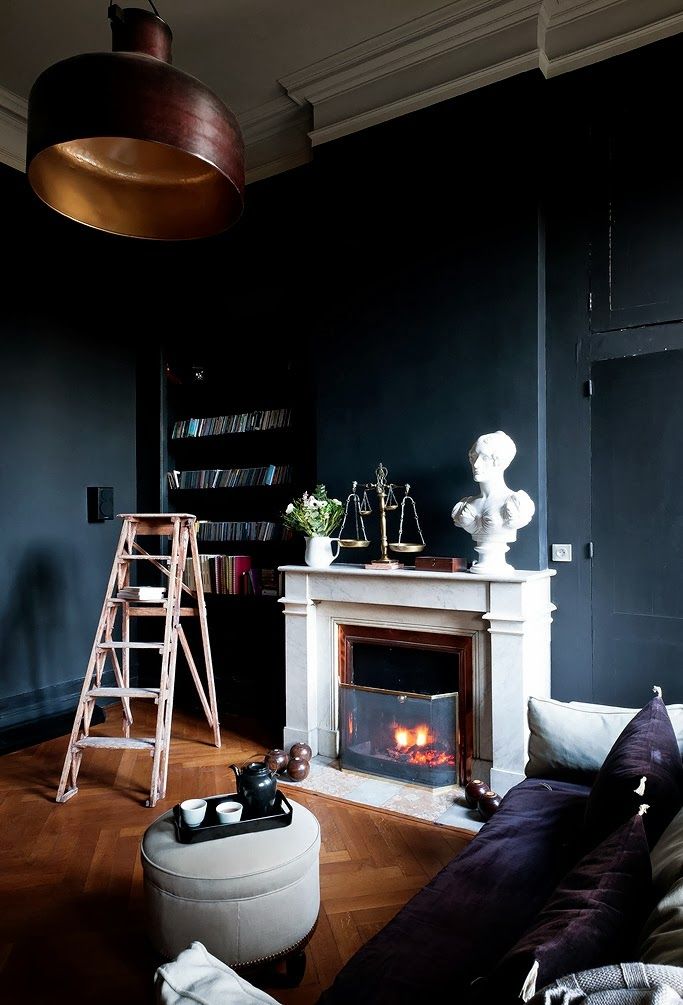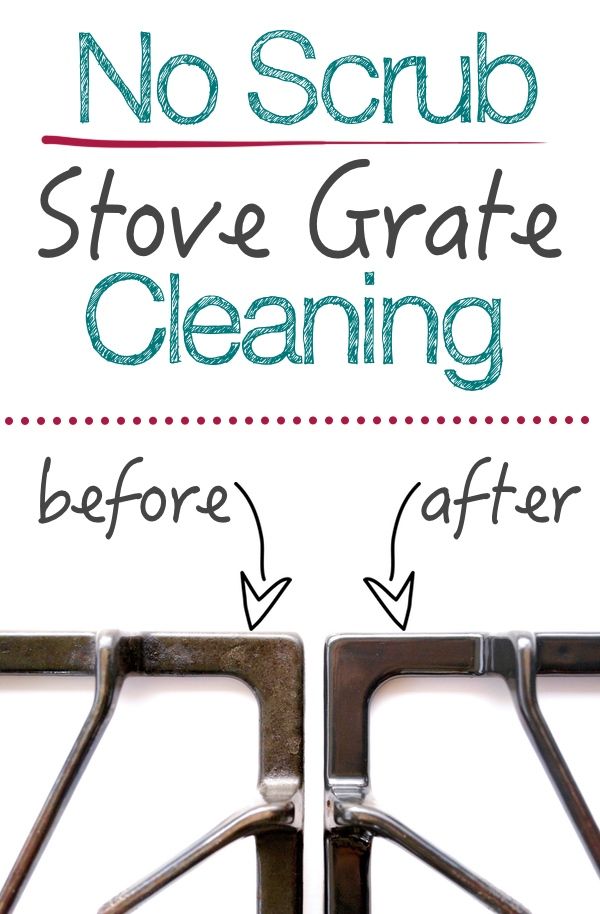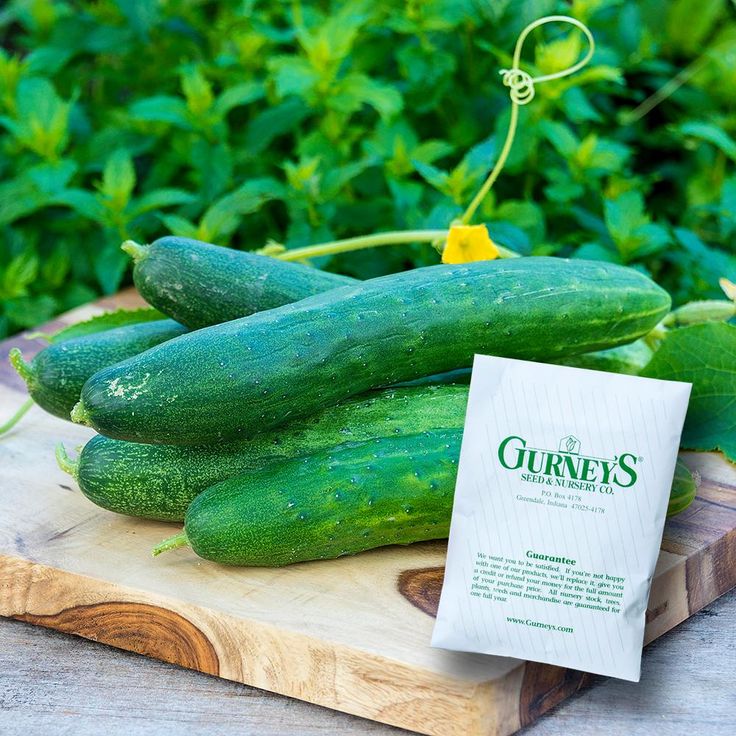Pantry shelf spacing height
What Is the Ideal Height For Pantry Shelves?
*This post may have affiliate links, which means I may receive commissions if you choose to purchase through links I provide (at no extra cost to you). As an Amazon Associate I earn from qualifying purchases. Please read my disclaimer for additional details.We are always looking for ways to make use of organizers, bins, and labels in order to keep a pantry organized.
While there are a number of accessories that will help you tidy your pantry, you need to consider your pantry shelves, especially at the placement and depth of these shelves.
What is the ideal height for pantry shelves?
The ideal height for pantry shelves can vary depending on your space and storage needs. However, there are industry best practices and considerations that can come in handy if you are remodeling or newly building a pantry.
Here we give you a few tips that will help you in determining the ideal height of your pantry shelves.
Table of Contents
Shelves Should Not Be Too Deep
The standard depth of pantry shelves is 16 to 20 inches, but the experts suggest that they should not be more than 12 inches deep. With deep shelves, it can be hard to see items that are stacked in front of one another.
Floor Clearance Requirement
The bottom shelf in a pantry should typically be 20-24 inches from the ground.
This extra space will give you the room for storing bulky items like paper towels and pet food while also keeping your own food items away from the floor space.
Extra Attention For Key Shelves
The shelves that are at the eye and waist level are the most commonly accessed because of their ease of reach. Therefore, it is best to keep the most frequently used items on this shelf.
These are the shelves on which you should put your bins and organizers and where people will (hopefully) put things back after using them.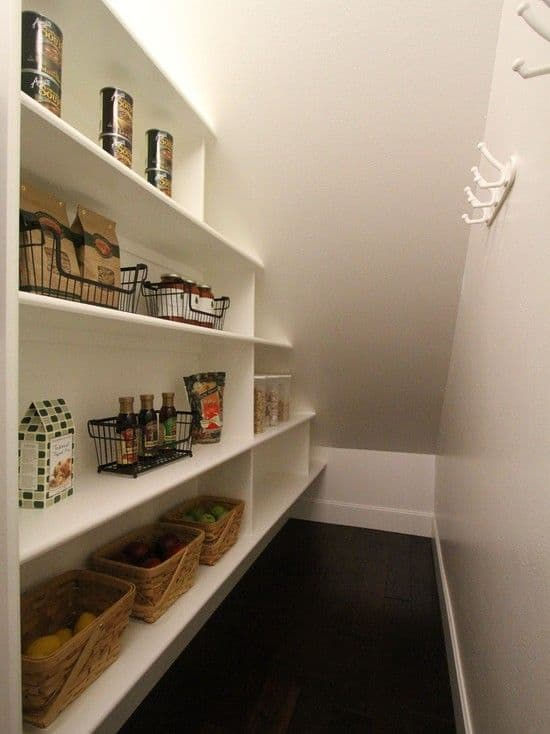
Tricks to Determine Shelf Height
The ideal shelf height partly depends on the type of goods that you are going to store in the shelf.
You should leave at least 2 inches space above the height of the tallest item. This will allow easy access of items and you will not have wasted space.
Some general rules are as follows:
- Canned Goods: 6.5 to 7 inches
- Cereal Boxes: 14 to 16 inches
- Large Items: 18 to 20 inches
Average Height of Common Pantry Goods
Canned GoodsThe general height of cans is about 4 inches. You will want to make sure these shelves have a height of 6 inches.
Mason JarsMason jars are typically 6.6 inches tall, so you will need a shelf with a height of 9 inches to have plenty of room.
When organizing items, mason jar contents often go along with canned goods. If you plan to store these together, be sure that your shelf height can accommodate the tallest items.
In order to store your spices, you need to have a pantry shelf approximately 6 inches in height. Most as most of the spice jars are around 4 inches tall, and this size will give you comfortable access.
BasketsBaskets are really helpful when it comes to storing things in a pantry. The best sized baskets for a pantry are 8 inches in height.
Wine BottlesA pantry can be a great place to store wine bottles since they can remain in a cool dark place that is easily accessible.
Wine bottles are usually 12 inches in height, so if you plan to store these upright, you will need a shelf with at least 14 inches of clearance.
Cereal BoxesKeep in mind that it is often recommended to store traditional wine bottles on their sides to retain the integrity of the cork. In that case, you may want to focus on a proper depth for your shelf, rather than height, for wine bottle storage in your pantry.

Cereal boxes are generally a little more than 12 inches in height. These taller items also tend to be lighter in weight and frequently accessed.
You might want to consider placing a taller shelf where you (or your kids) can easily reach on a daily basis. If your shelves are deep, you can also place the boxes on their sides for easier storage.
Large GoodsLarge goods can vary in size and shape with items such as sparkling water, potatoes, or paper products.
These are generally placed at extremes, either the top of the bottom of the pantry. Heavier items should be placed toward the bottom to make them easier to access as needed.
Tips for Getting Your Pantry Just Right
Do Not Go Too Deep
Experts recommend that the depth of pantry shelves should not be more than 12 inches.
When shelves are extra deep, items can become buried inside or difficult to access. You might even forget what you have stored toward the back!
You might even forget what you have stored toward the back!
Get Adjustable Shelves
Adjustable shelves will give you flexibility to create your pantry exactly how you need it. Over time, you can adjust the height of the shelves to accommodate different sized items.
Store Like Items Together
Classifying your pantry in one way or the other is a great way to keep your pantry organized. You can arrange your containers according to height on these pantry shelves and group similar items or items commonly used together.
Read This Before You Put in a Pantry
85 percent of home buyers considered a kitchen pantry “essential” or “desirable,” the National Association of Home Builders reports. In existing homes, there’s a clear drive to add and improve pantries, ranging from walk-in pantries to improvised solutions like open pantry shelving along basement stairs.
Pantries typically hold groceries, but no one says you can’t squeeze in a few platters, small appliances, and baskets to hold linens, paper goods, and cleaning supplies.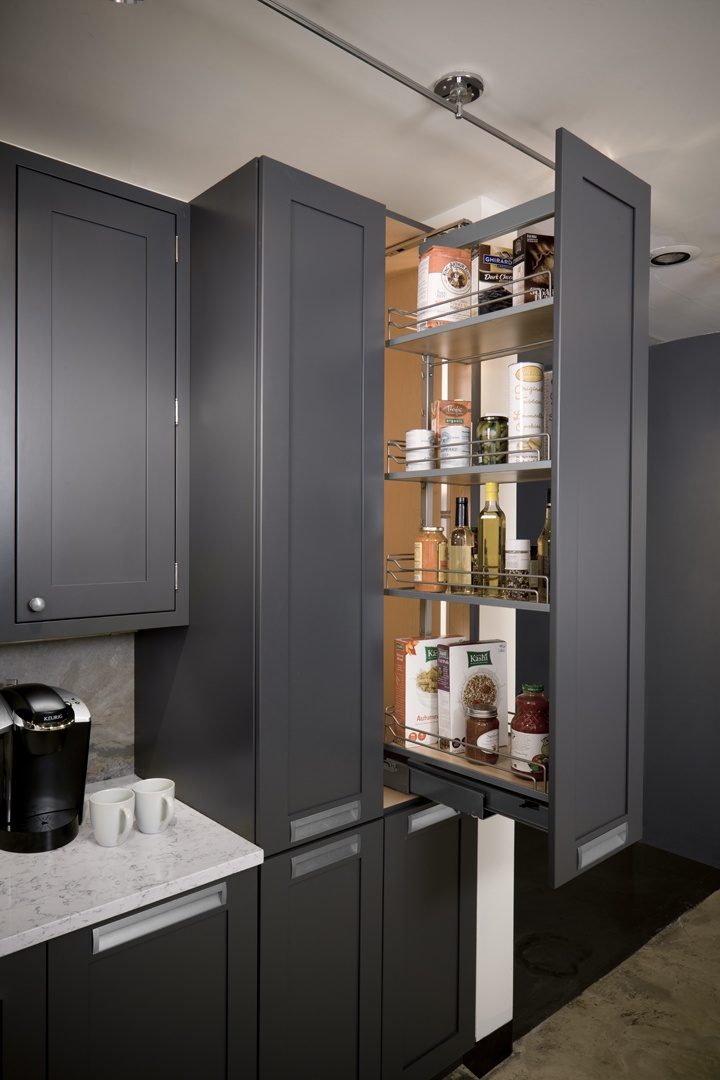 Go ahead: Add the dog bowl too.
Go ahead: Add the dog bowl too.
Organize Your Space with Kitchen Pantry Shelving
Shown: This compact, well-lighted place has many of the features found in larger pantries, including sturdy shelves, the bottom ones topped by a useful work surface and finished with a face frame and baseboard-style trim. Paneled, windowed doors and stone-like flooring offer function while also giving the pantry an inviting look and integrating it with the surrounding space.Rob Karosis/Crisp ArchitectsWhat’s key is a pleasing sense of order—another way of saying that even the tallest pantries need a place for everything and everything in its place. Read on for the details, whether you are building from scratch or reworking what you have.
Take Stock of What You Store in Your Pantry
Groceries
To start, figure out what you want to stash—or plug in—right there, whether it’s a lifetime supply of vanilla, a blender, cookbooks, your grandmother’s soup tureen, a folding ladder, or fondue forks you unearth once a year. Don’t wait until the shelves and niches are in—plan for your inventory and any outlets first.
Don’t wait until the shelves and niches are in—plan for your inventory and any outlets first.
Extra Cookware
Turn the top shelf into a colorful display of occasional-use pots and pans.
Countertop Appliances
Pull forward the ones you forgot you had. (Like you, Mr. Pasta Machine.)
Big Items
Got a step stool, an ice-cream maker, enough kibble to feed a kennel?
Select the Ideal Placement for Your Pantry Shelving
Michelle DrewesThe ideal spot is cool, dry, and convenient. A gut reno offers the most options, but it’s not the only way to go.
Annex Space
Instead of taking down an interior wall to, say, open up the kitchen to the dining room, consider moving that wall to create space for a pantry on the kitchen side.
Tap a Recess
Pantry shelves can be added to a wall near prep space or can even fit between studs.
RepurposeIf you aren’t getting a lot of use out of a coat or broom closet, picture it as a pantry.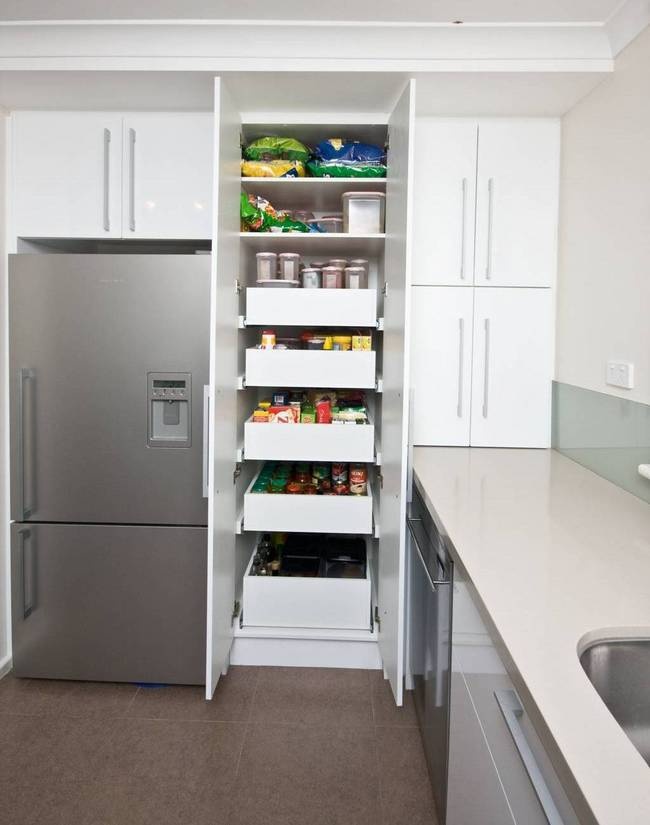 There’s no law against setting aside a spot in it for the dustpan, too.
There’s no law against setting aside a spot in it for the dustpan, too.
Colonial pantries were often unheated, shed-like lean-tos. Today’s equivalent is a one-story rear addition that could include a half bath or mudroom.
Look Down
If you have a cool, dry basement, pop in a freestanding unit; sturdy, open wire shelves hold everything and are easy to access. Or hang boxed open shelves along the stairs—the steps will be a built-in ladder.
Consider Your Shelving Options
Laura MossSize and Depth for a Walk-In Pantry and Adjustable Pantry Shelves
Typically about 5 by 5 feet, walk-ins can be lined with U-shaped open shelves or cabinets and finished with or without a countertop.
Adjustable shelves offer flexibility. Start with bottom shelves 16 to 18 inches deep and spaced about 18 to 24 inches apart, for bulky items; make shelves at eye level 12 to 14 inches deep and spaced 14 to 16 inches apart to fit cereal boxes and canisters.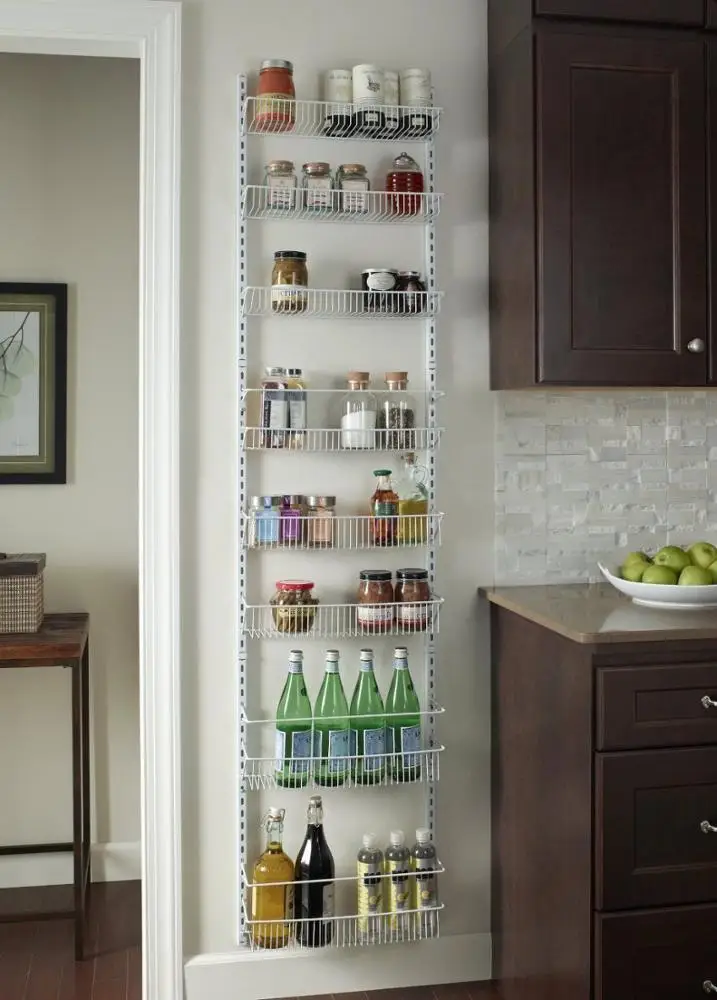 Shelves for spices and cans may need no more than 6 inches front to back. When planning for any item, add 2 inches of vertical space so you can tip or slide it in and out easily.
Shelves for spices and cans may need no more than 6 inches front to back. When planning for any item, add 2 inches of vertical space so you can tip or slide it in and out easily.
- Plywood is the go-to material for shelves—edges can be finished with iron-on veneer banding or wood trim—but other materials can work, too (if you’re careful; see below).
- If you hate looking at stuff, install cabinets. If dust is the issue, not clutter, opt for uppers with traditional glass fronts.
- Avoid door jams by paying careful attention to where doors swing, whether it’s on a cupboard inside the pantry or leading to the pantry itself. Some pantries omit doors altogether.
- Light it up with a ceiling fixture—a pendant can be pretty—or rechargeable puck lights with motion sensors.
- Avoid hide-and-seek by storing smaller items on organizers like lazy Susans and tiered shelf inserts.
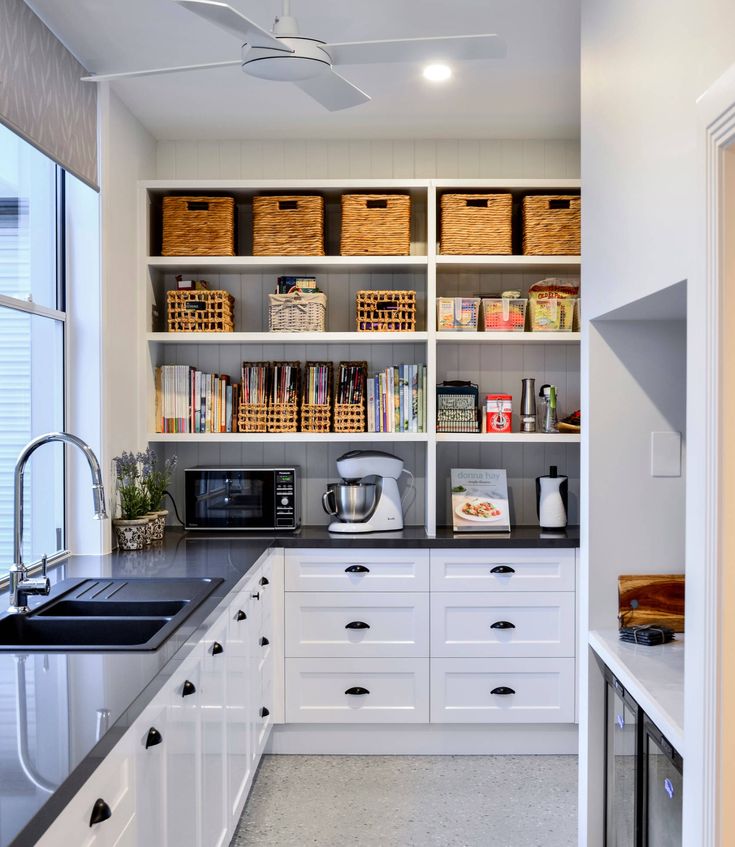
- Keep it cool and dry, ideally below 70°F and 45 percent humidity. No AC? Plug in a small dehumidifier. No outlet? Try a moisture-absorber like those made by Arm & Hammer.
TIP: Think about adding outlets behind shelved small appliances, including a microwave.
Make Sure There is Enough Space Between Shelves
Before choosing a material for the shelves (3⁄4-inch plywood, half-inch MDF…), search “Sagulator” online to figure out how far the shelf can span before bowing under the weight of books and canned goods.
Reach-In
Courtesy Starmark CabinetryTypically about 5 feet wide and 2 feet deep, reach-ins can also be as shallow as 16 inches, making them a natural fit along a wall with a recess or soffit. The reach-in at left was customized with paneled sliding doors and enough vertical space to stash a trash can during parties.
Decide How Big Your Pantry Should Be- Maximize floor space by opting for pocket or sliding doors.
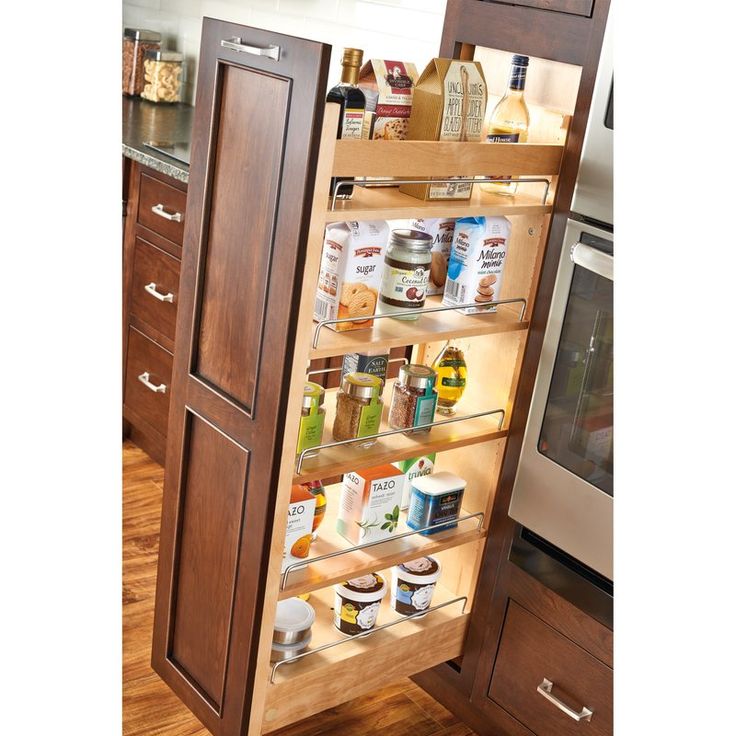 Keep in mind that they can be heavy and require maneuvering to get full access. Doors that swing out ease access; just make sure they don’t block traffic if left open. Doors can be omitted, of course, but they do hide things.
Keep in mind that they can be heavy and require maneuvering to get full access. Doors that swing out ease access; just make sure they don’t block traffic if left open. Doors can be omitted, of course, but they do hide things. - Accommodate oversize items by letting them sit on the floor, no bottom shelf needed.
- Measure and allocate space to meet your needs—extra head space for tall canisters, for example. Create cubbies, maybe one for trays and platters, another for a baking or coffee station. (You remembered the outlets, right?)
- Unify the pantry and adjacent space with coordinated finishes, especially when omitting doors.
TIP: Doors that slide or fold are prone to wobbling and sticking, so don’t skimp on the track hardware.
Wall-To-Wall Pantry with Sliding Barn Doors
Sliding barn doors with exposed hardware, as shown, double as a focal point.Brian Vanden BrinkIf you have a windowless wall in the kitchen or a nearby hall or mudroom, consider building in shelves with or without doors.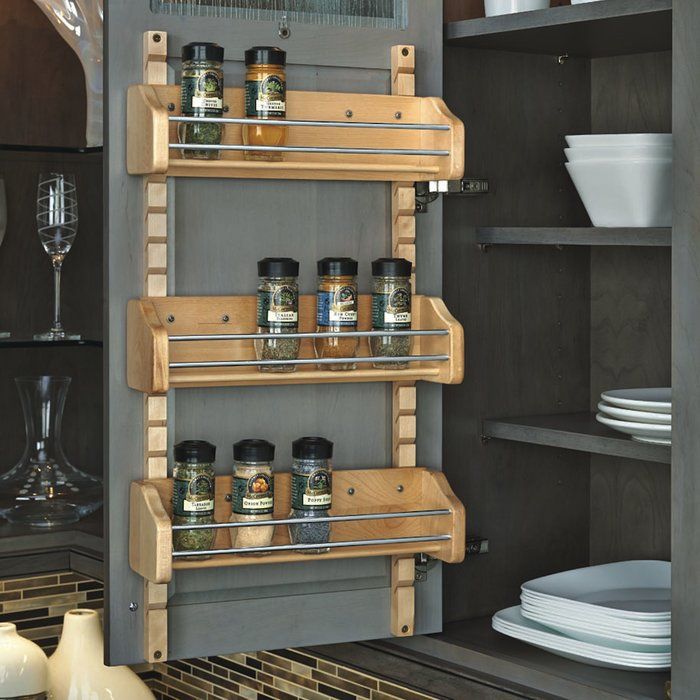 Open shelves offer the convenience of being able to quickly grab what you need, but they can also be a magnet for clutter and dust.
Open shelves offer the convenience of being able to quickly grab what you need, but they can also be a magnet for clutter and dust.
Wall-To-Wall Pantry with Open Shelves
Brianne WilliamsOpen shelves are typically a uniform depth. Pro organizers favor shelves no deeper than 14 inches to keep everything front and center.
Group like items so you don’t have to scan the entire wall or move doors looking for the pretzels.
Use baskets and ceramics (shown) to create a nice shelfscape.
Pantry Cabinet Options: “Batwing”
Courtesy Lewis Alderson & Co.To answer the call for pantry-style storage, cabinetmakers now offer options that blend in with the rest of the kitchen storage, from simple upgrades like a tall pullout to full-blown built-ins with hutch-like appeal.
TIP: Before lining cabinet doors with extra shelves, make sure there’s room inside for the doors to close.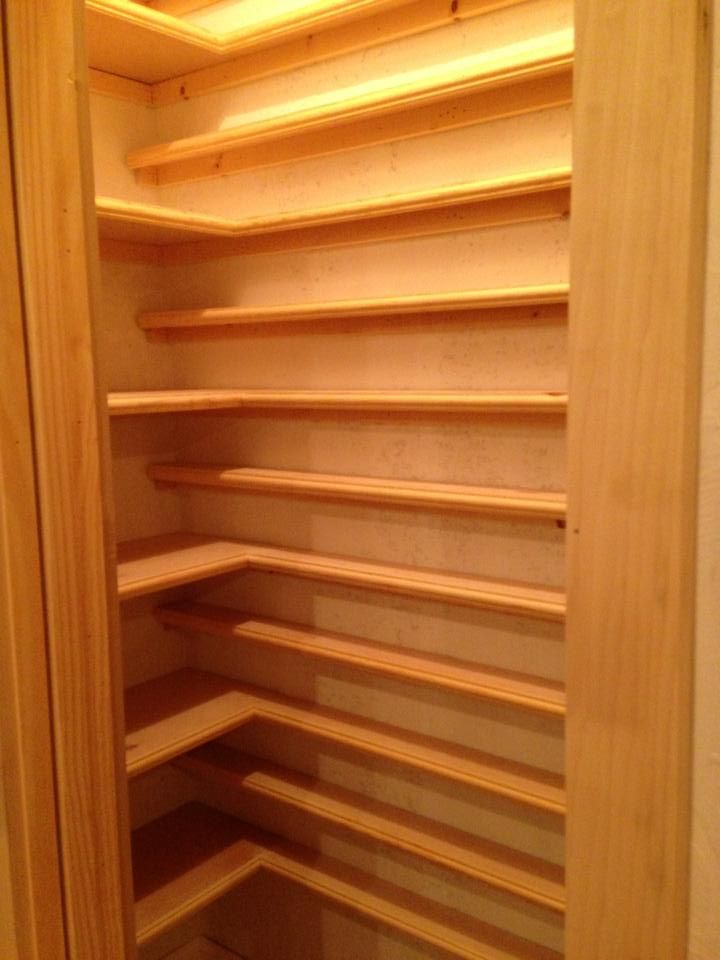
“Batwing” pantry cabinets mirror French-door refrigerators, with restricted door swings and bottom-mount drawers. Custom models, like the one shown above, allow quick access to essentials, while drawers hide other stuff.
Pantry Cabinet Options: Narrow Slide-Outs
Andrea RuggNarrow slide-outs, (pictured), are open on both sides and make use of awkward space; Rev-A-Shelf makes a retrofit just 3 inches wide. Try before buying: Heavy-duty hardware is a must.
Cabinet upgrades include wooden rollout trays that come in different widths and depths and can be installed at varying heights, depending on what you want to store. Again,it’s worth paying extra for heavy-duty glides. They should operate smoothly under a weighty load.
Found Spaces: Tucked Under Stairs
Gina BiancanielloOlder houses aren’t famous for their surplus closets and rooms, but they do have nooks and crannies that can be converted into pantries or colonized by freestanding furniture.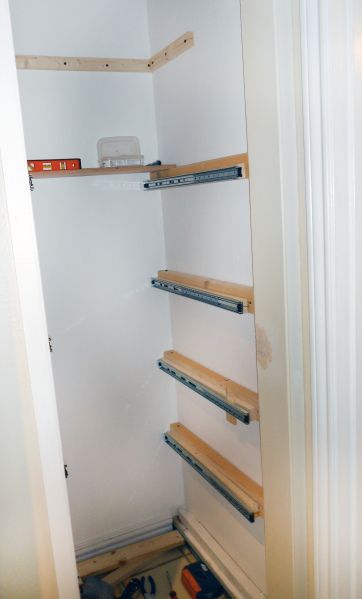
Tucked under the stairs, this hideaway makes creative use of former dead space, complete with push-latch doors that blend with the paneled wall, shallow built-in shelves, lighting, and a baking cart that rolls right into the kitchen.
Found Spaces: Freestanding Kitchen Pantry Cabinet
Gridley + GravesFreestanding storage like this unpainted vintage hutch can add warmth as well as function. Look for strong shelves that keep everyday items easy to see and reach.
Safe Pantry Storage
Store your goods in containers suited to their contents. From left: Woven baskets with handles, like these Sedona totes, are ideal for linens and come lidded or not; from $25, Crate & Barrel.
BPA-free, dishwasher-safe Brilliance containers make rapid-turnover items like cereal and pasta easy to see; from $4.99, Rubbermaid.
Stoneware canisters with tight-fitting, gasket-equipped lids protect whole spices like cinnamon sticks and bay leaves from light and premature aging; from $25, Le Creuset.
Erasable food labels (not shown) can post purchase dates; $6.50, Jokari.
It’s Not a Morgue
Always a good idea to check an item’s shelf life, available online, or you may risk SES (sudden expiration syndrome).
- Olive oil is vulnerable to heat, light, oxygen—and time. Open it within six months, then store it in the fridge.
- Whole grains-—brown rice, popcorn-, oatmeal—and flours can get stale in months. Think about refrigerating or vacuum-packing them (Foodsaver) once open.
- Nuts can also turn rancid—pine nuts after only a month, pecans after four. Hoarders should stash them in the freezer.
- Ground spices fade fast. Freezing can cause condensation; keep them in the pantry, but replace them once or twice a year.
Make It Special: Throw a Curve
Ellen McDermottYes, it’s a hardworking space where function trumps frills.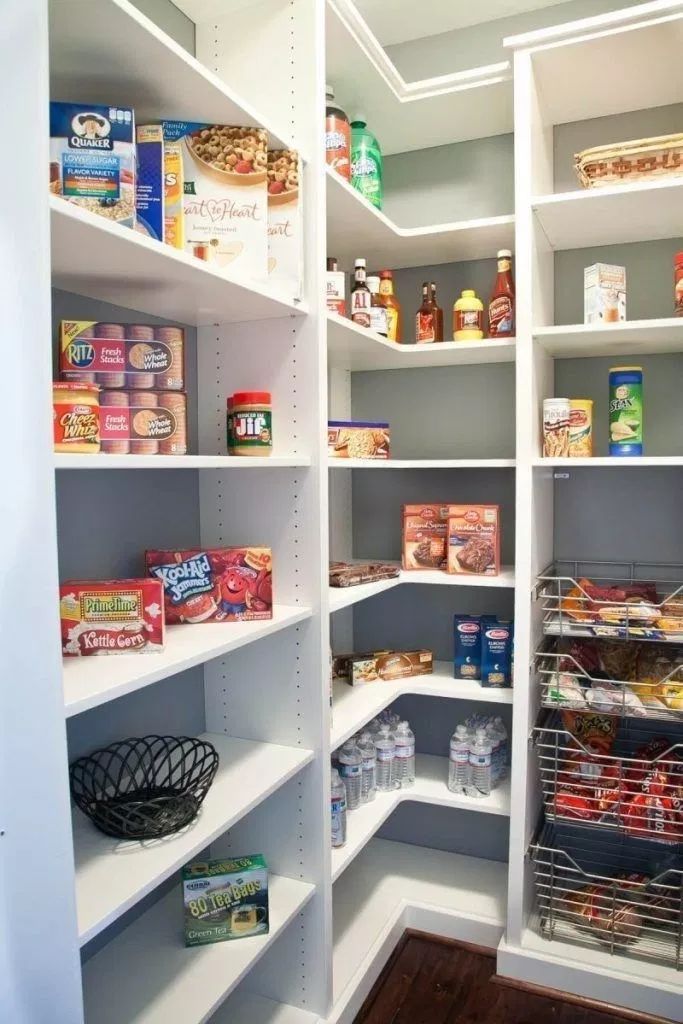 But that doesn’t mean your pantry shouldn’t strut some style. Here, three colorful upgrades to consider.
But that doesn’t mean your pantry shouldn’t strut some style. Here, three colorful upgrades to consider.
THROW A CURVE. Rounded shelves eliminate sharp corners; shallow ones for spices and condiments can be made with perforated aluminum (McNichols).
Make It Special: Hang a Decorative Door
Tria GiovanHelp define the space while offering glimpses inside with a salvaged screen door or a reproduction like this (Vintage Doors).
Make It Special: Trim It Out
Corey GafferEvoke period lace shelf edging with easy-to-paint MDF Victorian Running Trim (Victorian Woodshop) and add wood brackets (Vintage Woodworks).
Design: Martha O’Hara Interiors
Thanks to: The Kennebec Company, Bath, ME; Catherine Seiberling Pond; Kathy Marshall; Scott Davis, Closet Maid; Tori Cohen.
How to make shelves in the pantry with your own hands? 40+ photos and videos
Features of planning storage systems
The most important thing when arranging a pantry in an apartment or private house is to decide what things it will be intended for and correlate the load with the dimensions of the room.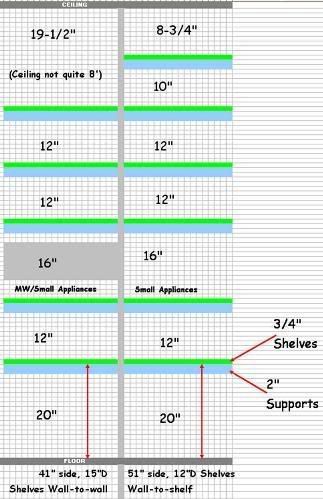
- For a small closet, several rows of shelves placed one above the other are suitable. At the bottom it is better to leave room for boxes and boxes: this way the area will be used optimally.
- The dimensions of the compartments must be made in accordance with the dimensions of the items that will be removed in the pantry.
- If the room has a high ceiling, it is worth providing a place for a stool or stepladder: it will be more convenient to get things from the upper shelves.
- Some pantries have enough free space to make deep shelves. This is not always convenient, and besides, you should leave a distance for the passage and bringing in objects.
Preparation
Before installing storage systems, the pantry needs to be repaired: clean the space, carry out dry and wet cleaning, remove old wallpaper and flooring. If necessary, the walls of the pantry or attic are leveled and also put in order: painted or pasted over.
It is recommended to use a primer containing antifungal impregnations.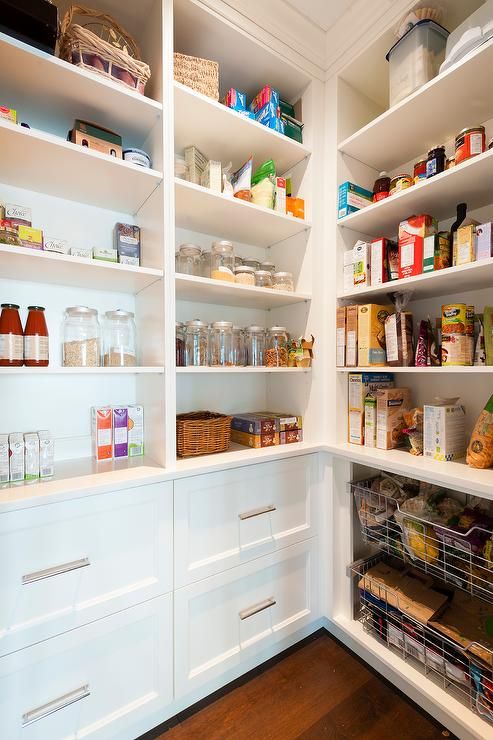
Laminate, parquet or linoleum is laid on the floor. It is also worth equipping the pantry with ventilation and lighting, which will greatly facilitate the use of the room.
Which material can be used?
One of the most affordable and durable materials for creating shelves in the pantry is wood. Boards made of natural wood (pine, larch), as well as chipboard, are fixed to metal fasteners. The heavier the items that will be stored in the pantry, the thicker the boards should be. For conservation, large equipment, construction tools and other heavy things, it is worth providing an additional stiffener.
If you make shelves in the pantry with your own hands, you can use what is at hand - wooden pallets, old unnecessary furniture, plastic fruit boxes. Plywood is considered a budget option, but thin sheets are not suitable for heavy items. Lightweight but durable plastic is suitable for storing books, clothes and bulk products. It is easy to care for it, besides, the material is not afraid of moisture.
Metal racks are considered the most durable and do not require additional reinforcement. Modern products have a collapsible design, they are easy to rearrange and transport, in addition, the material easily withstands temperature changes. When buying, you should pay attention to the coating - it must be protected from corrosion with a special composition.
Pictured are shelving, drawers and wall shelves for a spacious pantry.
How best to arrange the shelves in the closet?
The size of the utility room primarily affects the placement of shelves.
- A small closet (about 2 meters) allows you to install shelves in only one row - linearly, along one wall. Sometimes designs are made rounded - this shape allows you to win a few centimeters and use three walls.
- The corner arrangement in the form of the letter "L" is considered much more practical, but the storage area must exceed 2 meters. For maneuvers, you need to leave a small passage, especially if the room is elongated and narrow.
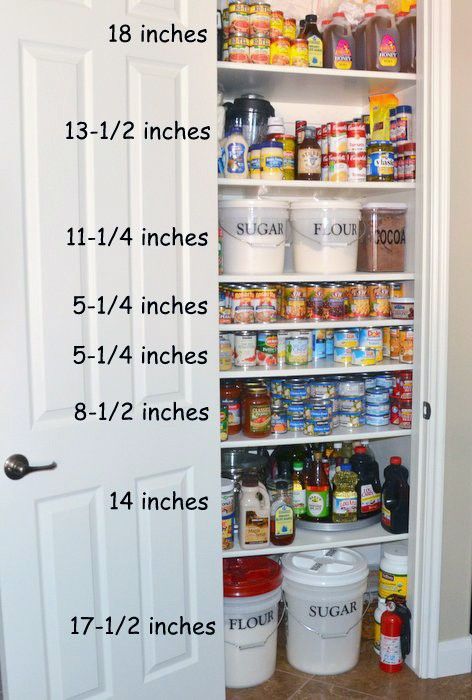
- In a large utility room, it is best to place shelves in the shape of the letter "P". In this case, it is necessary to calculate the depth of the structures so that there is room for movement in the middle.
The photo shows a pantry in which the racks are functionally arranged in the shape of the letter "P".
Deciding on the dimensions
The most popular and practical form of shelves is straight. The length of the shelf is usually equal to the length of the wall. If the distance between opposite walls is 2 meters or less, then the shelf does not need additional support. Otherwise, the structure should be strengthened, especially if it is planned to store rolls and tools.
The thicker the wooden shelf, the more fasteners it requires. Also, its strength is determined by the distance between the support posts: the more massive the structure, the smaller the gaps.
In order to use the shelves comfortably and safely, the heaviest items must be stowed down.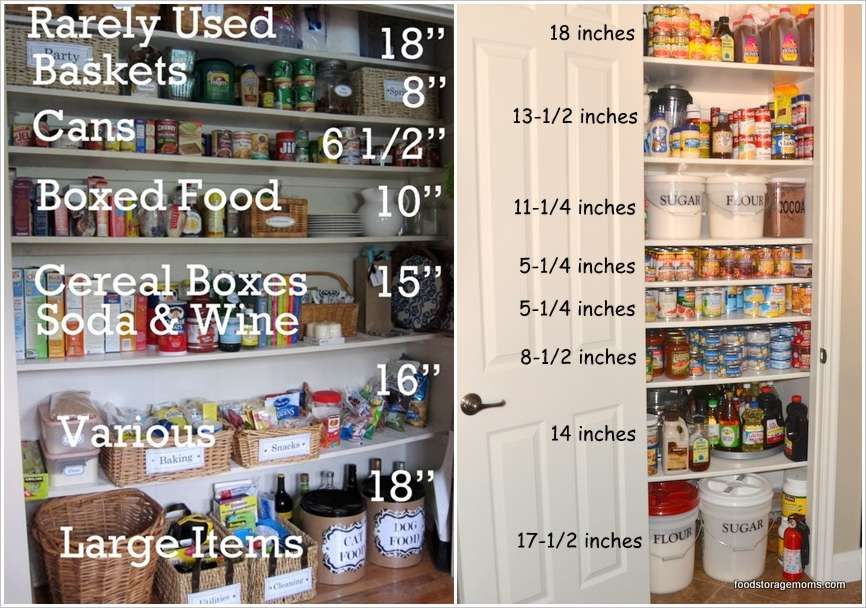 The width of the protrusions should decrease from bottom to top. The standard shelf width for cans with preservation is 30 cm. The height depends on the dimensions of things.
The width of the protrusions should decrease from bottom to top. The standard shelf width for cans with preservation is 30 cm. The height depends on the dimensions of things.
Pictured is a pantry with a wide aisle between wooden shelving.
DIY Shelf Options: Step-by-Step Instructions
You can save your family budget with homemade pantry shelves and detailed tutorials below.
How to make a wooden shelving unit for a pantry?
Before starting work, it is necessary to measure the walls of the pantry and create a drawing of the desired structure. Next, prepare in advance the consumables necessary for the manufacture of functional shelves.
The photo shows a linear self-made shelving made of wood, occupying the entire wall of the closet.
Tools and materials
For work you will need:
- Planed block for a vertical post (8 pcs, about 2 m).
- Beam for horizontal supports (12 pieces, approx.
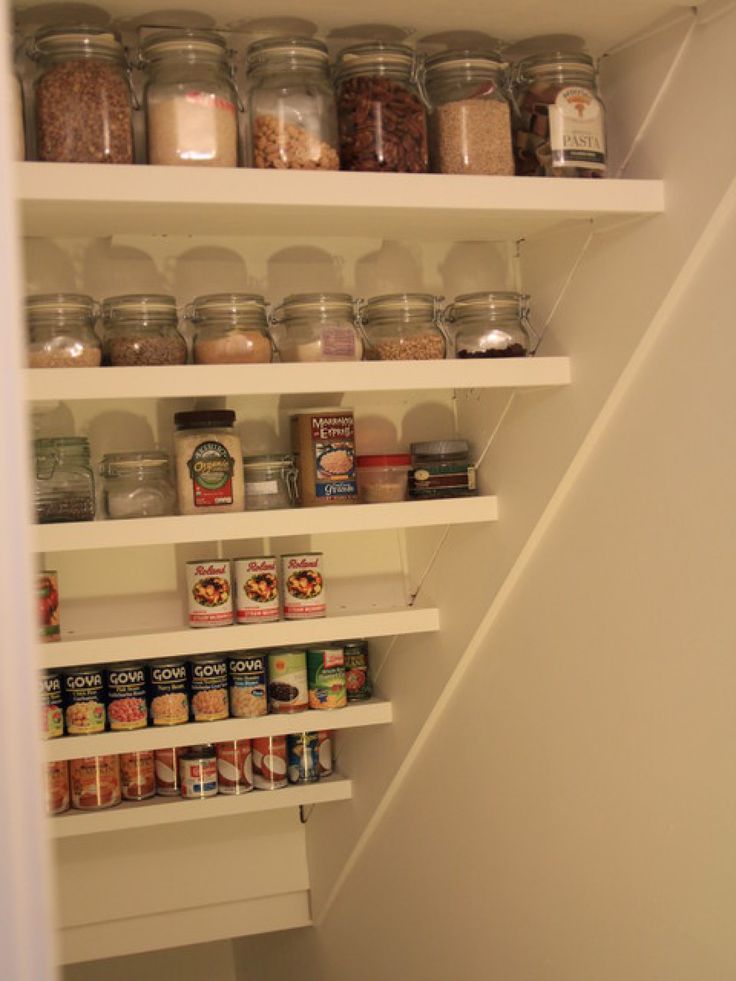 50 cm, depending on the depth of the rack).
50 cm, depending on the depth of the rack). - Boards or lining for shelves (the number depends on the depth of the shelves, the length - on the length of the wall).
- 16 metal corner fasteners (corners).
- 45 screws (3.5x25).
- About 70 thin studs.
- Wood impregnation and brush.
- Building level.
- Roulette.
- Hammer.
- Electric jigsaw.
- Screwdriver.
Step-by-step instructions
- First you need to prepare the material. Using a hacksaw or electric jigsaw, we cut the bars and lining in accordance with the dimensions of the future pantry rack.
- We apply impregnation, carefully processing every detail. You need to dry for as long as indicated in the instructions on the bank.
- We fix the corners with screws at the level where the shelves will be located:
- We fix horizontal bars as follows (4 such structures should be obtained):
- We install the lining horizontally, nail it with thin nails:
- We make the second shelf in the same way: we fasten the corners, fix the horizontal bars, attach the lining.
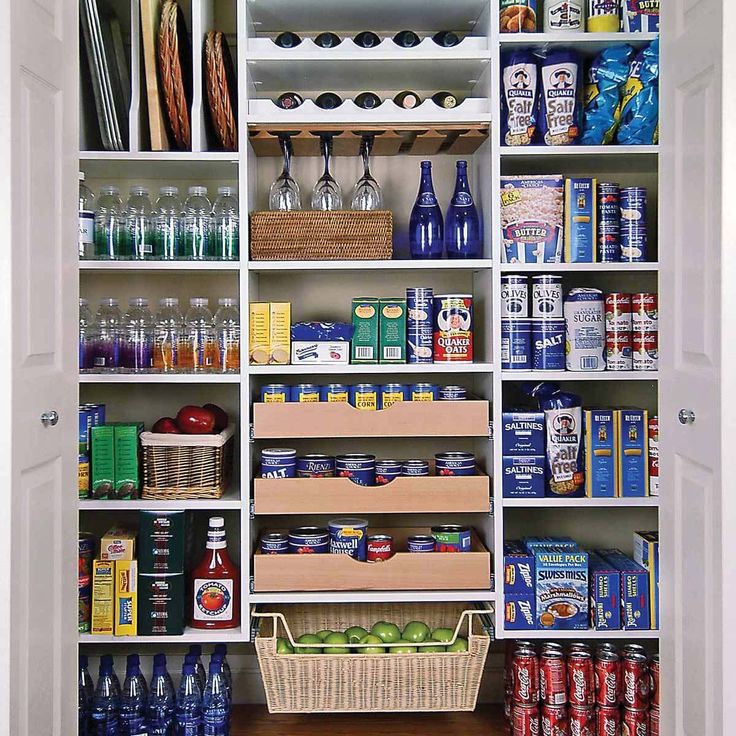
- We lay the upper horizontal bars, fasten them.
-
The shelves in the pantry are ready. In this way, you can make a rack of any height, depth and shape.
You can learn more about how to make shelves in the pantry from this video:
DIY wall shelves
This is the easiest and most economical way to make hanging shelves for a small closet. The amount of material for the shelves depends on the size of the room and the number of floors.
In the photo there are pantries in small apartments such as Khrushchev or Leningradka, equipped with simple shelves.
Tools and materials
To make shelves in the pantry with your own hands, you will need:
- Planed bars.
- Plywood, chipboard, boards or remnants of old furniture.
- Self-tapping screws for fastening.
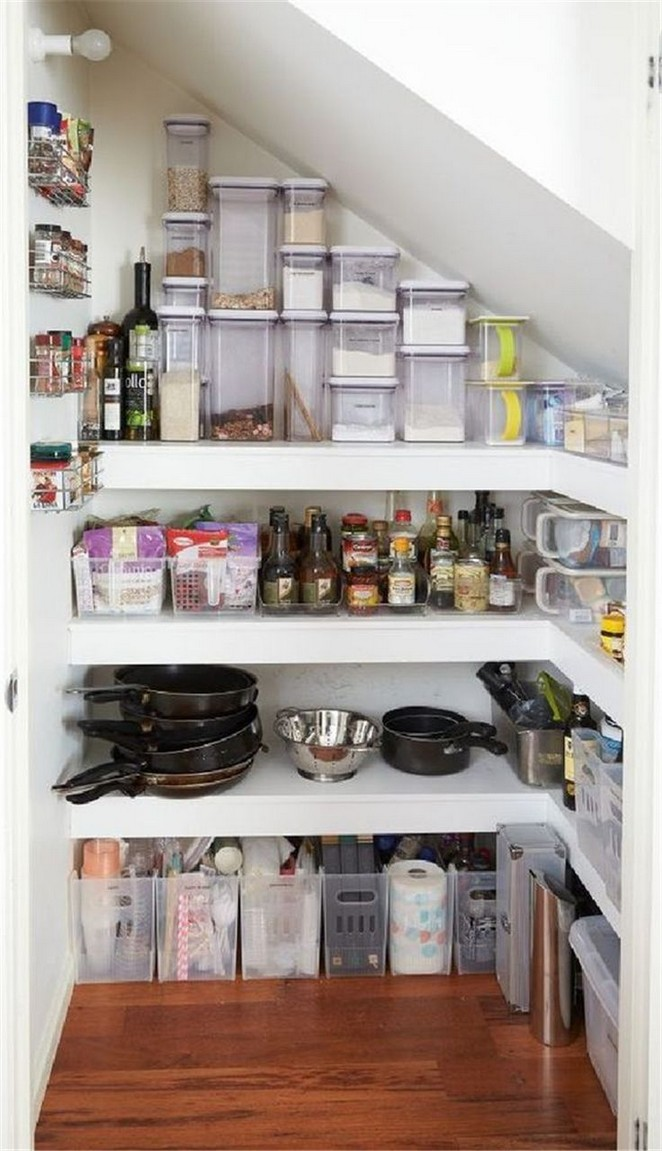
- Screwdriver.
- Thin nails.
- Hammer.
- Level.
- Jigsaw or hacksaw.
Step-by-step instructions
- Sawing timber and plywood according to the size of the pantry. If desired, they can be painted or varnished. For the frame of one shelf, you will need 1 long and 2 short bars, for the base - a plywood sheet or boards of the required size and thickness. We make markings on the walls and securely fasten the bars.
- Making markings for the next shelf.
- We mount the shelf in the pantry.
- We fix it with nails.
And this video shows how to install a wall shelf in the pantry in two ways: on the brackets for chipboard and on the standard brackets.
Shelves in the pantry from the profile
Solid U-shaped shelving for a spacious pantry is obtained from metal profiles. Having understood the principle of operation, you can make shelves of any configuration, replace plywood with wood, cover the metal profile with paint and create a loft-style rack.
Having understood the principle of operation, you can make shelves of any configuration, replace plywood with wood, cover the metal profile with paint and create a loft-style rack.
The photo shows two types of shelves for the pantry, made by hand from metal profiles and wood.
Tools and materials
- Guide profiles 50x40.
- Guide profiles 50x50.
- Plywood or wooden boards.
- Roulette.
- Building level.
- Metal shears.
- Electric jigsaw.
- Screwdriver.
- Dowel-nails.
- Self-tapping screws.
- Ladder.
Step-by-step instructions
- We make a drawing and calculate the amount of materials. We cut the profile into components in accordance with the dimensions.
- Marking out horizontal lines. We fasten guide profiles 50x40 to the walls using dowel-nails.
- We make the frame of the first shelf, put it on temporary supports from the profile.
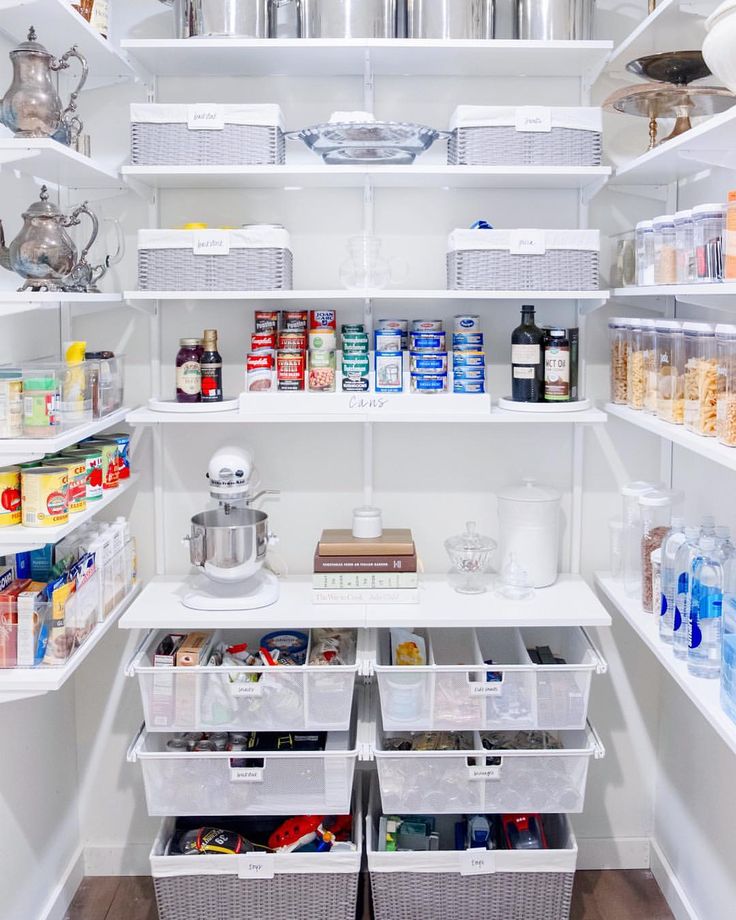
- We cut a sheet of plywood with an electric jigsaw:
- We fix the finished parts with self-tapping screws.
- We replace temporary racks with rails. Shelves on the walls in the pantry are ready.
This video clearly shows how to make shelves in the pantry from the profile:
Photo gallery
You can see other options for shelves in the pantry in the photo selection below.
How to make your own shelving and shelves for a closet
The current developers, unlike their colleagues of the past generation, do not seek to equip the living area with storage rooms. This increases the living space, but does not allow you to optimize the space and have the storage area that is sometimes necessary.
The presence of a pantry in the apartment becomes a gift for the hostess and sometimes a luxury inaccessible to others.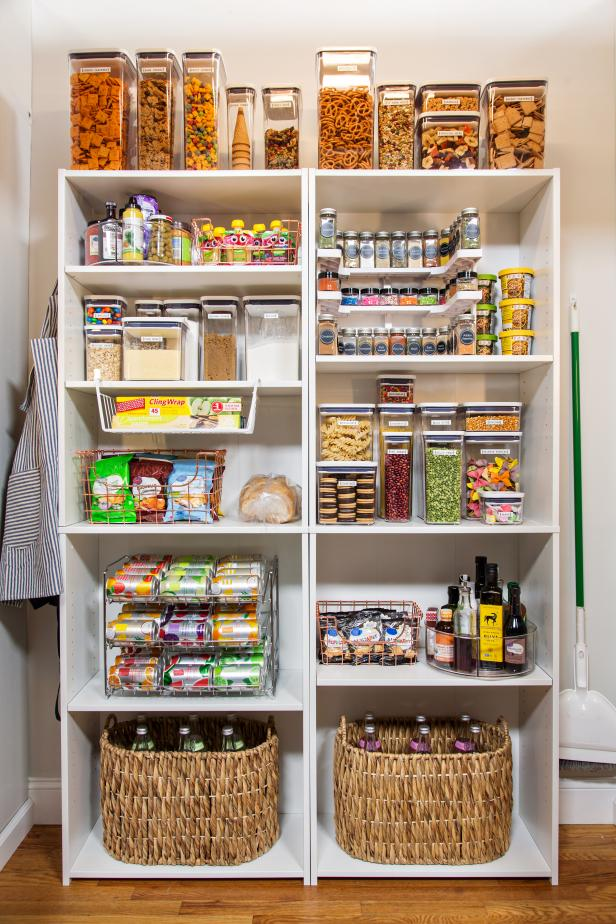
Unfortunately, the pantry is not always equipped with shelves and racks for placing and storing things, so you have to install the shelves in the pantry yourself.
Do-it-yourself shelving in the closet is a simple task.
Contents
- 1 Design, construction and mounting methods
- 2 Required materials
- 3 Tools for work
- 4 Choosing a place for a shelf
- 5 DIY manufacturing and installation process
- 7 Shelves in pantries - 50 photo ideas:
Design, construction and fastening methods
wall.
There are only two options for how to make a rack, namely to make a free-standing shelf, or simply fix the boards directly to the wall.
First, it's worth drawing the idea on paper. This will allow you to visualize the desired rack, take measurements and most successfully place it, taking into account the wishes and intended storage items.
In order for a closet to be equipped with shelving, there must be enough space in it.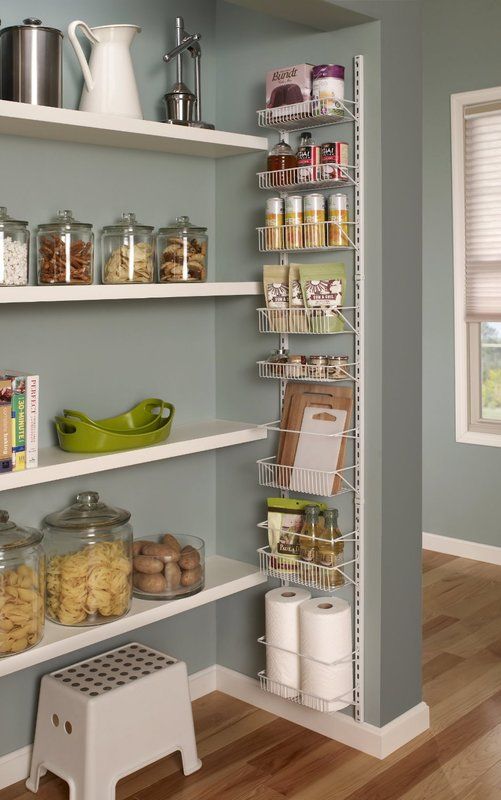
Keep in mind that the shelves should be arranged in width from bottom to top, that is, the bottom shelf will be the widest, and the top one, respectively, the narrowest. This is due to the fact that the most dimensional items that are inconvenient and impractical to lift up will be stored on the lower shelves.
You need to think carefully about the distance between the shelves and correlate it with the items that you plan to store.
Depending on the desire of the owners, the racks can have any shape that will allow the implementation of the place chosen for fastening the structure.
You need to take into account the amount of free space - if the racks take up too much space, then it will be inconvenient for you to walk in the pantry.
U-shaped and L-shaped are more often chosen, this type of shelves is the most practical. For installation, it is better to prefer metal brackets and fasteners, they are the most durable, they can withstand any weight on the shelves.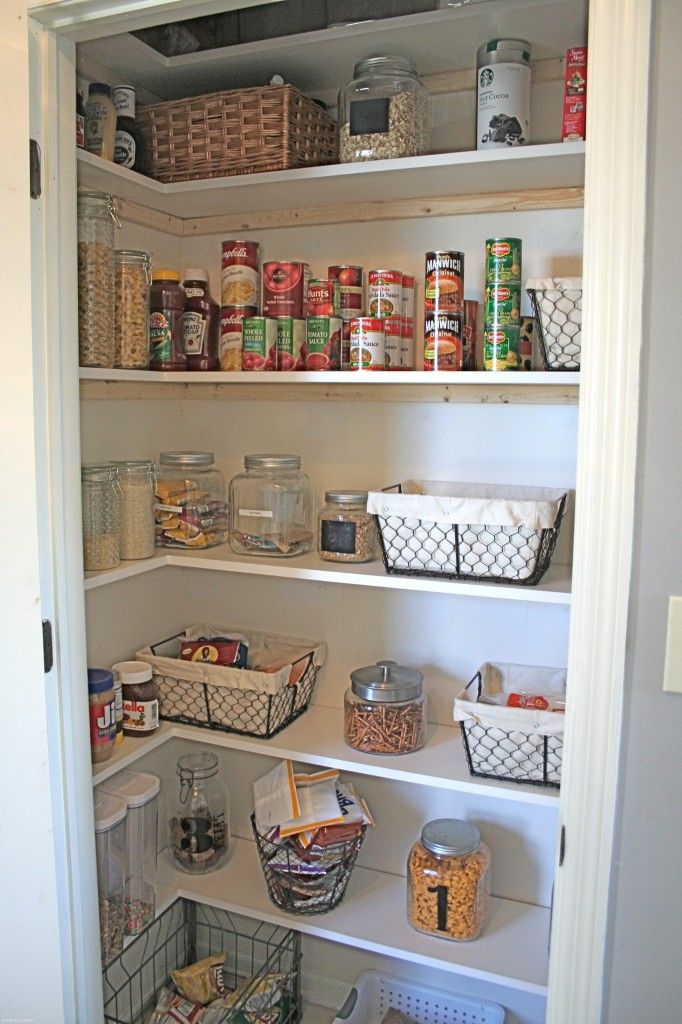
Choose whichever option suits you.
Required materials
When deciding how to make shelves in the pantry, you need to decide on the material from which the structure will be made. There are several options.
- Budget option allows you to make shelves from the material that is part of the furniture. If there is an old wall-slide or an unnecessary chest of drawers available, then they can be disassembled and you can get a fairly durable and, at the same time, free canvas for making boards.
This will be enough to have good and reliable shelves in the pantry, on which you can store anything.
- The second option involves the purchase of material for shelves in the pantry. The choice should correspond to the list of intended items for storage, their dimensions, weight.
It is advisable to make the rack directly in the pantry, because if it is large, then it will be difficult for you to bring it inside.
If the shelving is expected to be loaded with conservation, then a solid board with a width of about 30 mm is the best choice.
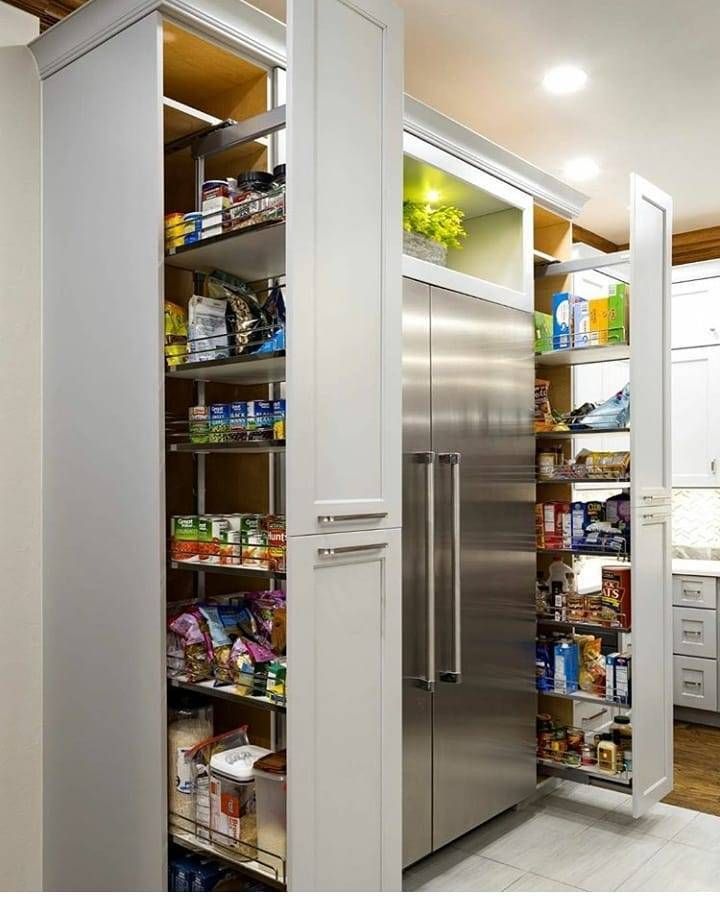
Boards are suitable for any - the main thing is that they have sufficient length and withstand the expected load.
In addition to wooden materials, you can choose others, the main thing is durability and the possibility of self-assembly. In addition to the shelves, you should stock up on fasteners on which the shelves will be installed, consumables necessary for work.
In order to make wooden storage shelving, you will need few materials and serious tools.
Tools for the job
To understand what tool is needed for the job, you need to clarify what exactly needs to be done. If the material for the shelves is not prepared and needs to be cut and sharpened to the desired dimensions, then it is imperative to have a jigsaw or a hacksaw for wood and a planer. They will help to make the shelves the right size. And you will also need sandpaper to process the edges of the cuts and give the shelves a finished look.
Tools needed for the job.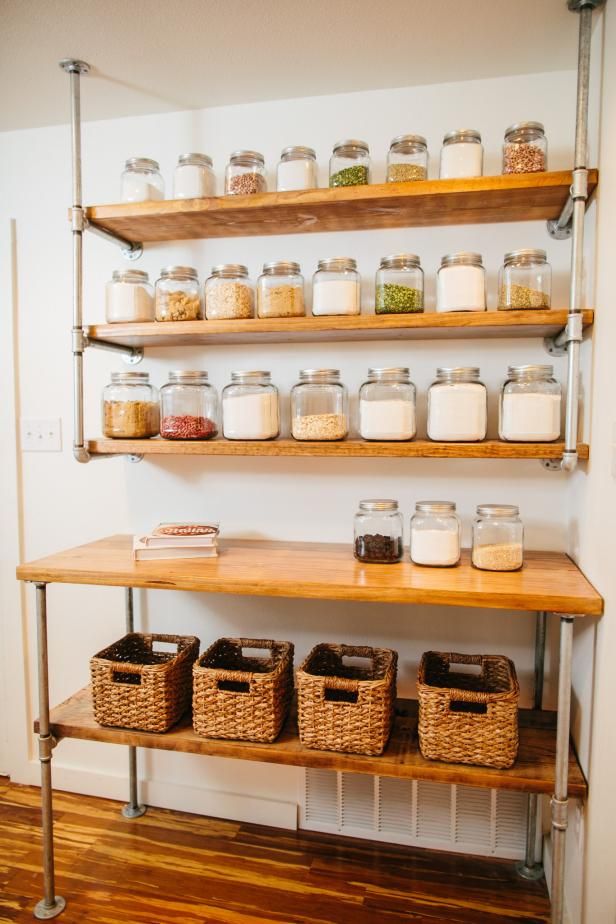
Requires a puncher to create holes in the wall for dowel-nails to attach brackets, a screwdriver to connect parts to each other, if necessary.
This is enough to have good and reliable shelves in the pantry, on which you can store anything.
Without fail you will need:
Choosing a place for a shelf
When thinking about how to make shelves in a pantry, it is important to decide on a place. The place where the shelves will be attached should be chosen taking into account many factors.
The wall to be fastened to must be load-bearing.
This is a guarantee of strength and durability of the structure. A thin interior partition may not withstand the load and shelves filled with heavy objects will collapse.
In addition to boards, chipboard, plywood and other suitable materials can be used.
If the fastening is not carried out directly to the wall, then you can use your imagination according to the desired form of arrangement.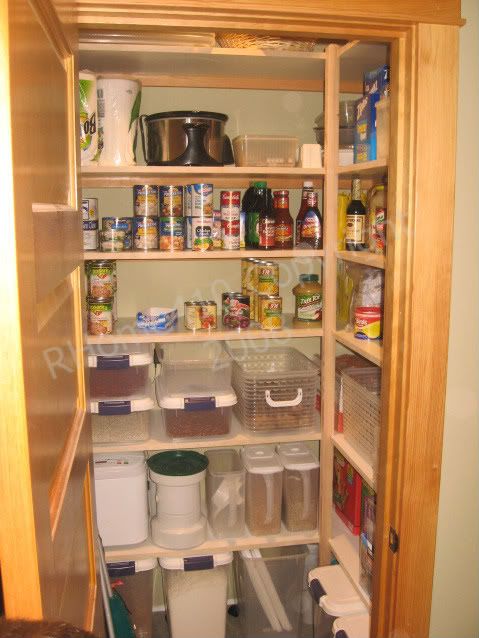
Consider the dimensions of the items to be stored.
It is important to prepare the storage room itself, align and tidy up the walls in advance so that the shelves stand up straight and there is no need to adjust them to the wall relief.
Lighting needs to be taken care of before shelving is installed.
The process of manufacturing and installation
So, the place for the rack has been chosen, all the tools and materials have been prepared, the layout of the shelves on paper has been made, and all dimensions have been verified and calculated? You can proceed to the main process of manufacturing shelves and assembling the structure.
- The first thing to do is to use a tape measure and a building level to mark the wall, which will serve as the basis for fastening.
Use a tape measure to mark the height of the shelves in the center of the room and draw horizontal lines using a laser level.
Use a puncher to make holes in the wall where the brackets will be attached.
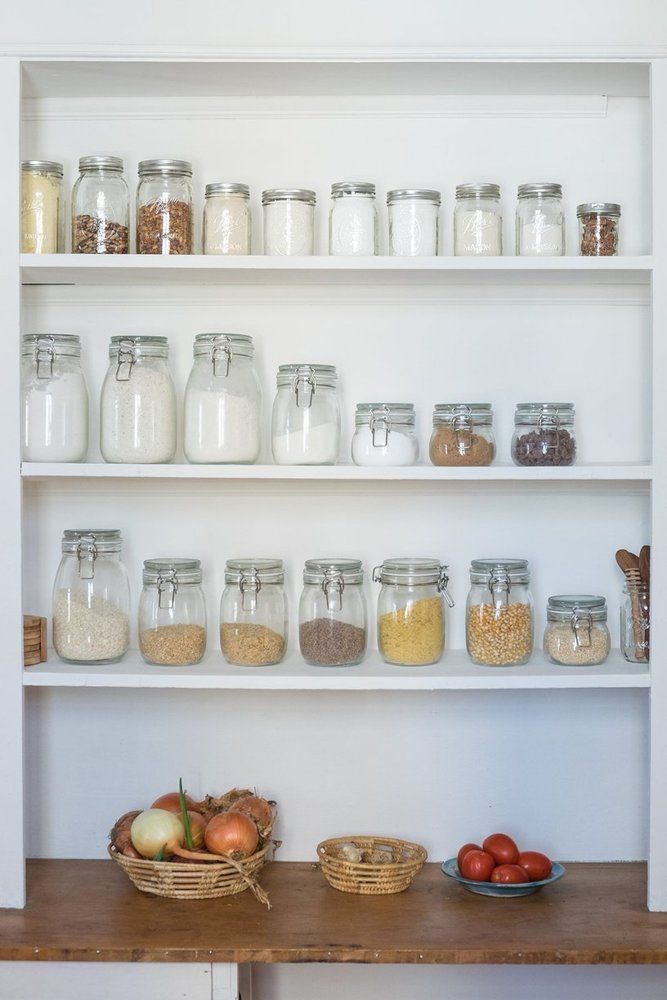
Guide profiles are attached to the walls with dowel-nails.
Fasten the bases for the brackets and install them.
Their number depends on the desired number of shelves, and the distance between them determines the height of the shelves.
- The next step is the manufacture of shelves. You need to use a jigsaw or a saw to cut shelves from wood to the required size.
It is better to check the dimensions again and cut out the template from cardboard for greater accuracy.
After checking them with the installed brackets, you can start trimming. After the shelves of the desired size are cut, it is worth processing the cuts with sandpaper to remove the roughness.
This will give the shelves a decent look.
- After fixing the brackets and cutting out the required dimensions of the shelves, it is necessary to install the latter in the place of the planned location and secure with fasteners and a screwdriver.


